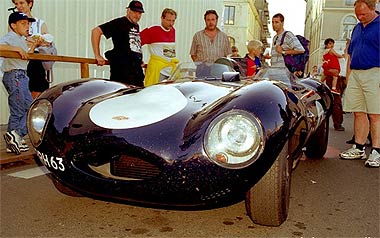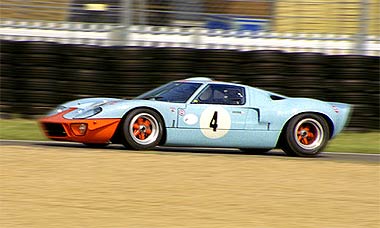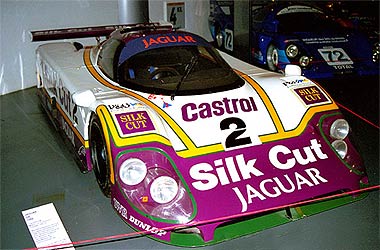Le Mans - historical
The races at Le Mans has been held since 1923 and therefore full of history. Both race cars, the track and the rules has been changed many times since the beginning but always the same main purpose with the race: to get the race car through the 24 hour of racing and in the same time cover the longest distance.
Back in the 1920s the rules were not very extensive - the race cars were still in the making - and even though the top speeds were enormous for that time it did not call for huge sets of rules. The race for cover the fast laps at the track got the engineers to develop parts for the cars, which not only made the car quick, but also made the car stop more efficient and headlights which could light up the road even at the high racing speeds.

Jaguar D-type
Le Mans became the place where a car producer took his masterpiece to show the world what it could do. Just to finish the 24 hours of hard race was, and still is today, a quality sign for the car brand.
After Second World War:
The post war racecar industry were positively affected by the engineering triumphs of the World War where for example the aviation engine technology could be used for race cars as well. At the same time the racecars became more streamlined and aerodynamically optimized.
In 1955 Le Mans experienced its worst catastrophe to day: During the race Pierre Levegh crashed his Mercedes and killed himself and 77 spectators. This incident made Mercedes withdrawing from all kinds of motor racing. A decision which was in force in over 30 years!
In the 1960s Ferrari was the winning brand at Le Mans and when Henry Ford II wanted to win the race he offered Mr. Enzo Ferrari to buy his company and convert Ferrari to Ford. Enzo Ferrari refused the offer and Mr. Ford had to develop a winning car himself. This resulted in the Ford GT40, which in 1966 broke the five-year of Ferrari dominants at Le Mans. The Ford GT40 was so superior that it won all the Le Mans races from 1966 to 1969.

Ford GT40
In the 1970s the Le Mans racecars grew to furious race machines instead of the prior road car look. It was Porsche who started this trend with powerful racecars. In 1969 they discovered that the regulations allowed big five-liter racecars provided that there was produced minimum 25 cars. The rule was made to let older cars such as the Ford GT40 to race, but as Porsche produced racecars in a large numbers anyway, they had no problems in producing the demanded 25 cars. So at the Geneve car show in 1969 the Porsche 917 was introduced, and there were already 25 cars ready so the Porsche 917 could be approved. The appearance of the Porsche 917 made Ferrari to build the Ferrari 512 which did not manage to win at Le Mans - a battle immortalized by Steeve McQueen in the 1971 movie Le Mans.

Porsche 917k
The Group-C days:
Besides the Porsche 917 then the 1970s was dominated by the French brand Matra with its 3 victories in a row. In the late 1970s there was a debate going on how the regulations for sportscar racing should evolve. This debate resulted in the Group C category, which began in 1982 - a class, which got its own world championship with the race at Le Mans as one of the events in the serie. The Group C was prototype racecars and the regulation implied among other restricted fuel consumption. Typically only 600 liters of fuel was available for a 1.000 km race, and 2.600 liters for a 24-hour race.
When the Group C was introduced in 1982, Porsche introduced its 956 and the racecar became a huge success at Le Mans: In 1982 three cars participated in the race, and when the chequered flag dropped they were placed as first, second and third - and with a comfortable 11 lap down to the car in fourth place!
The Group C category became a battlefield for the big car manufactures, and during the 1980s all the major brands participated: Porsche, Jaguar, Mercedes, Toyota, Nissan, Mazda and Aston Martin. Also the minor car manufactures and a lot of privateers took part in the Group C category. The technological development of the cars was huge. Most visible were the aerodynamically improvements, but also the level of car safety were improved. The cars also took advantage of the newly developments in electronic products. For example the engine management systems were introduced at Le Mans in the middle of the 1980s, something the privateers complained about, as they could not afford it. They argued that now it was no longer the drivers and mechanics it relied on - now it was depending on who had written the software controlling the air intake to the carburetor.
The 1980s became the decade where a Danish driver drove at Le Mans. Jens Winther was the first Dane as he in 1983 drove at Le Mans in a BMW M1. The following year Jens Winter came back with another Dane - Lars Viggo Jensen - and in 1985 a third Dane entered the Le Mans circuit: John Nielsen. However he did not manage to take the start as he during qualifying took off in his Sauber Mercedes C8 and did two backward flips before the car hit the ground on all four wheels. John Nielsen was miraculous not hurt but the car did make it.
Later more Danes have driven at Le Mans. Both Thorkild Thyrring, Kris Nissen and Kurt Thiim have been there. You can see the full list of Danish Competitors at Le Mans here: link.

Jaguar XJR-9LM
In the middle of the 1980s the Porshe 956 got a upgrade and was now known as the Porsche 962. The 956 and 962 was the winning brand at Le Mans from 1982 to 1987. In 1988 Jaguar broke this 6 years Porsche tradition when Jan Lammers, Andy Wallace and Johnny Dumfries won at Le Mans in a Jaguar XJR9-LM. In 1989 it was Mercedes, which had a win at Le Mans – 34 years after a Mercedes killed 77 spectators during the 1955 race. The Mercedes comeback became known as the Return of the Silver Arrows with reference to the classical silver paint and shape of the Mercedes.
The changing 90s:
Durring the 1980s the Group C cars has been developed to super fast sportscars exploiting the newest technological improvements: Aerodynamically and ground-effect shapings on the cars, improved tyres and the introduction of carbon fiber as chassis material. In the late 1980s the organizers had decided that the top speed of the cars racing down the Mulsanne straight needed to be lowered, and for the race in 1990 two chicanes had been build dividing the Mulsanne straight into three parts. This transformed the circuit from a high speed track where the aerodynamically parts had been adjusted for a high top speed, to a track where the cornering speeds were more important for the entire lap time. Due to this fact the transformations on the cars from the 1989 to the 1990 race were easy to spot.

The Le Mans trophy from 1990
In 1990 John Nielsen became the first Danish driver to take a win at Le Mans. It was in a Jaguar XJR-12 - a victory that made the 70.000 British spectators to invade the track Sunday afternoon at 4 pm. This mend that John never crossed the finish line.
In the beginning of the 1990s there were a lot of rumors about various teams wanting to take up Formula one racing, and the International Motor racing organization FIA had figured out that it would be most unlikely that a car manufacture would both run Sportscar racing and Formula one. Therefore FIA made a change of regulations so engines could be used for both Formula one racing and for Sportscar racing. For Le Mans in 1991 a transitional rule so racecars with the new 3.5-liters engines became favored compared with the old 6-liters engines.
The result of FIAs bright ideas together with the weak economically situation in motor racing resulted in 1993 in the introduction of the GT class at Le Mans. The GT class was much cheaper to run than the expensive Group C cars, and also the spectators could more easily identify the GT cars with their own car (or at least their road legal dream cars). In 1993 cars like Porsche 911, Venturi, Lotus Esprit and Jaguar XJ220C made a stand against the Group C cars - a battle ending with the first GT car finishing 69 laps behind the Group C winning car at Le Mans.

Jaguar XJ220C
1993 was the last year where the real Group C cars drove at Le Mans as the class was closed down at the end of that year. Some of the old Group C cars were back at Le Mans in 1994 - this time racing as Le Mans Prototypes and when only production cars were allowed at Le Mans in 1994, the old Porsche 962 had became a ´roadcar´ run under the name Dauer Porsche.
The trend with GT cars at Le Mans was present throughout the rest of the 1990s. However prototype cars were allowed and to make the competition between GT and prototypes more even, the regulation was changed so the two classes could compete equally.
In 1995 the McLaren F1 GTR drove to victory at Le Mans. The car was originally build as a roadcar - although the world fastest roadcar - but was taken to Le Mans by the car owners, and gained 4 of the first 5 places. OK, the rain was purring down in the main part of the race and thereby blurring the advantages of the prototype cars over the GT cars, but still the McLaren victory in 1995 became great history.

McLaren F1 roadcar
Porsche had developed a sports prototype for the 1995 race at Le Mans, but with a very short notice short before the race, the regulations were changed in a way, which limited the Porsches performance. This made Porsche mad at the organizers and as a response they withdrew their entry. The following year the privateer team Joest Racing had taken over the car, the Porsche WSC-95. Despite the change of regulations the car showed great performance in both the 1996 and 1997 Le Mans event, as it won both races. In 1997 the car was shared with our Danish driver Tom Kristensen who wrote Danish motorsport history becoming the second Danish driver to win at Le Mans - and it was at his first attempt!

Tom Kristensen, Michele Alboreto and Steffan Johansson, Le Mans 1997
In the late 1990s all the major car manufactures had decided to show what they could do at Le Mans, and in 1999 brands as Toyota, BMW, Mercedes, Audi and Nissan were racing as manufacture teams. Toyota had built a racecar for the 1998 race using the regulations to the limit. This was the Toyota GT.One - the car which had its gasoline tank in its compulsory trunk, and reminded you of the old Jaguar XJR14 Group C car from the beginning of the 1990s.

BMW V12, Yannick Dalmas
The battle in 1999 went like this: Mercedes, which had made a big aerodynamically failure of a car, experienced that two of its three entered cars took off and flew like a small airplane. The third car was taken out of the race. Nissan lost a car under qualifying, and Audi could not decide if they could go for a closed GT car or an open-top prototype. Therefore Audi ran both two GT cars and two prototype cars. The GT cars turned out to be the weakest, while the prototype got a fine fourth place overall in it first Le Mans race. BMW won in front of Toyota and if it has not been due to a mechanical fault a few hours before the chequered flag Tom Kristensen could have won the 1999 race also.
Le Mans today:
... more text about the Le Mans races in the new Millennium.
>> Back to history